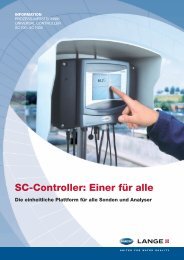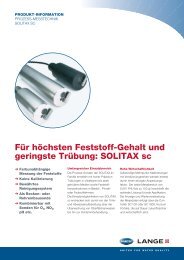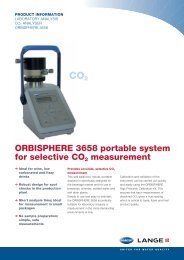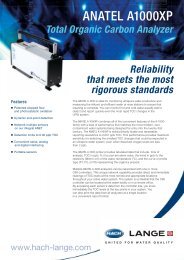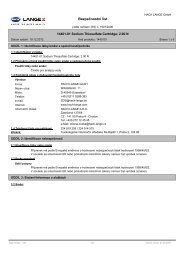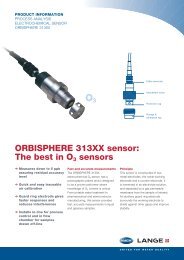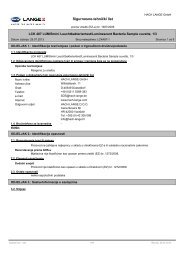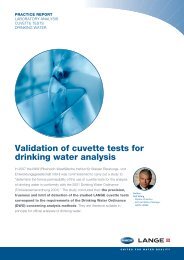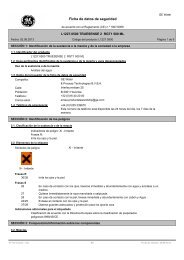Round robins with LANGE cuvette tests - HACH LANGE
Round robins with LANGE cuvette tests - HACH LANGE
Round robins with LANGE cuvette tests - HACH LANGE
You also want an ePaper? Increase the reach of your titles
YUMPU automatically turns print PDFs into web optimized ePapers that Google loves.
PRACTICE REPORTLABORATORY ANALYSISQUALITY ASSURANCEROUND ROBINConfidence in your results<strong>with</strong> <strong>LANGE</strong> <strong>cuvette</strong> <strong>tests</strong><strong>Round</strong> <strong>robins</strong> are an important element of analytical quality assurance.For more than 20 years, <strong>HACH</strong> <strong>LANGE</strong> users have performed well inthese <strong>tests</strong>. Irrespective of whether the round <strong>robins</strong> are organised by themanufacturer (ADDISTA) or by an independent institute, the qualityof the results is always excellent. This was recently demonstrated by the2007 international round robin held by Kiwa, an independent Dutchorganisation. More than 94 % of the <strong>LANGE</strong> <strong>cuvette</strong> test results werecorrect! For individual users, these documented results are proof of their goodworking practices and properly functioning analysis system. Their measuredvalues are also officially recognised.Author: Petra Pütz- “Diplom-Ingenieur”, chemistry- <strong>HACH</strong> <strong>LANGE</strong> applicationslaboratory products
2ANALYTICAL QUALITY ASSURANCE_ROUND ROBINS<strong>Round</strong> <strong>robins</strong>:analytical qualityFig. 1: ADDISTA for laboratory analysis: roundrobin solutions A and B for free participation in<strong>HACH</strong> <strong>LANGE</strong> round robin <strong>tests</strong>, and combinedstandard and spiking solution for internalquality checksWhy use a round robin test?<strong>Round</strong> robin <strong>tests</strong> are organised toenable users to check their workingpractices and their analysis systemsunder real conditions.In a round robin test, identical samplesare analysed by the participantsindependently of each other (externalquality control). In this way, the analysissystem and the working practices arechecked and any errors are identified.Official recognition of measured valuesalso requires regular participation inround robin <strong>tests</strong>.<strong>HACH</strong> <strong>LANGE</strong> round robin <strong>tests</strong><strong>HACH</strong> <strong>LANGE</strong> has offered its users theopportunity to participate in round robin<strong>tests</strong> free of charge since 1986!Today, ADDISTA solutions are availablefor more than 50 different <strong>cuvette</strong> <strong>tests</strong>,for both internal and external qualitycontrol.The results of the round <strong>robins</strong> verify thegood working practices of the users andthe quality of the total analysis system.In the past 10 years, an averageof almost 90 % of all submittedresults were correct!When users obtain significantly orrepeatedly flawed results, <strong>HACH</strong> <strong>LANGE</strong>works together <strong>with</strong> them to identify andeliminate the cause.AQA round robin(Baden-Württemberg)Number of correct <strong>cuvette</strong> test results ReferencemethodParameter 2004 2005 2006 2007 2005COD 89 % 90 % 88,5 % 90 % 92 %NH 4 -N 91 % 93 % 91,5 % 95 % 91 %NO 3 -N 92 % 89 % 91 % 91 % 93,5 %TN 87,5 % 88 % 88 % 89 % 88 %P tot. 89 % 89 % 90 % 91 % 92 %TOC 90 % 89 %Table 1: Comparison of the quality of the results obtained using operational analysis and referencemethods; results of the official round robin of the Institute for Sanitary Engineering of theUniversity of StuttgartFrequency (%)too low low correct high too highCompetitor 2Competitor 1<strong>HACH</strong> <strong>LANGE</strong>Independently organised round<strong>robins</strong>In view of the importance of externalquality checks, a growing number ofEuropean Institutes offer a variety ofsector-specific round <strong>robins</strong>. Eg, theInstitute for Sanitary Engineering of theUniversity of Stuttgart Deutschland hascarried out special round <strong>robins</strong> foroperational analysis in sewage treatmentplants for a number of years. Here, too,<strong>HACH</strong> <strong>LANGE</strong> users always obtainvery good results in comparisons <strong>with</strong>both reference analysis methods and itscompetitors (see Table 1 and Fig. 2).The Vorarlberg environment instituteobtained almost identical results in 2006when it carried out a sewage treatmentplant round robin for the parameter COD.Fig. 2: 2002 round robin of the Institute for Sanitary Engineering of the University of Stuttgart(comparison of COD methods); <strong>LANGE</strong> <strong>cuvette</strong> <strong>tests</strong> clearly outperformed the competition.www.hach-lange.com
3The results of the official laboratoryperformance test of Italy’s nationalISO agency UNICHIM are equallyunambiguous. Its comparison ofstandard methods and <strong>LANGE</strong> <strong>cuvette</strong><strong>tests</strong> showed:- the good comparability of theaverage values of both methods- the higher precision of theresults obtained using the<strong>LANGE</strong> <strong>cuvette</strong> <strong>tests</strong>2007 round robin test: qualitycontrol at an international levelIn November 2007, Kiwa WaterResearch, an accredited Dutch institute,organised a round robin involving300 participants from 18 Europeancountries. The analysed parameterswere COD (high + low), NH 4 -N, NO 3 -N,TN, ortho-PO 4 -P and P tot.The <strong>tests</strong> were carried out on realwastewater samples, which were spiked<strong>with</strong> two different concentrations of theanalysis parameters. Per parameter, theround robin test participants determinedtwo measurement results which differedby a known amount. This (Youden)concept simplifies rapid error analysiswhether differences are attributable tosystematic or random errors.<strong>Round</strong> robin documentionand qualityAll the users of municipal sewagetreatment plants, research laboratoriesand industrial companies contributedto the success of the round robintest through their cooperative andprofessional working methods: Morethan 94 % of all submittedmeasurement results werecorrect! (see Table 2)Evaluation of Kiwa round robin 2007Parameter Number ofmeasuredNumbercorrectvaluesTotal 2,640 >94 %Low COD 358 93 %High COD 274 >95 %NH 4 -N* 430 85 %*NO 3 -N 402 >95 %TN 382 >95 %Ortho PO 4 -P 370 >93 %P tot. 424 >95 %Table 2: Quality of the results obtained by<strong>HACH</strong> <strong>LANGE</strong> users in the international Kiwaround robin 2007* The result for NH 4 -N is a good example ofhow user errors can be revealed by a roundrobin. Many users carried out the analysis <strong>with</strong>a <strong>cuvette</strong> test for the wrong measuring range.Their deviating measurement results stood outimmediately when the round robin test wasevaluated.mg/l CODInternational round robin 2007: Results for high COD (LCK514, LCI400)140012001000Target value for sample 2: 980 mg/l COD800600Target value for sample 1: 510 mg/l COD400The results for the COD <strong>cuvette</strong> test arebetter than the average, as more than95 % of them are correct!Fig. 3 shows that the values, <strong>with</strong> theexception of isolated outliers, are alldistributed closely around the targetvalue (the continuous line). The verylow average scatter widths of 2.2 %(sample 1) and 1.4 % (sample 2)document the excellent quality of theworking practices and analysis system!20000 50 100 150 200 250 300Number of participantsFig. 3: COD measurement results from international round robin test 2007, organised by KiwaWater Research Institute, Netherlands
100 % checkingof preparedsolutionsPrecise dosage<strong>with</strong> DOSICAP ZIPPipette <strong>tests</strong>olutionPrecalibrated,preprogrammedSimple and safehandlingBuffer and standardsolutionsIncoming goodsinspectionReady-to-useformazin standardsCertifiedproduction10-foldrotationalmeasure mentADDISTAsystemSafety DataSheetsCustomercooperationDocuments ina variety oflanguagesAQA – Recommendations on frequency and quality targetsLDO Customerinnovation hotlineTest filters<strong>Round</strong>-the-clockavailabilityReliablemonitoring ofthreshold valuesQuality and batchcertificatesFast remotediagnosisOfficialrecognitionof resultsSeminars andworkshopsMade-to-measuremaintenancecontractsPracticecreportsLegal complianceTrainingcertificatesComprehensiveon-site safetyOperationalsettingsPlant optimisationQA MEASURE AIM/BENEFIT MINIMUM FREQUENCY QUALITY AIM 3Multiple determination Outlier recognition, increased precision Once per month 1 per operator and matrix Difference 10 %Preparation andutilisationExperienced employeeson siteRegular customerinformation by postand emailCost effective processcontrolStandard measurement Verification of work method, internal system monitoring With each 10 th sample; at least once per month 1 per operator Maintenance of confidence interval1 Plausibility checks Prevention of matrix-related false readings If implausible results are obtained or matrix changes occur, or at least once per quarter Difference 20 %<strong>Round</strong> robin <strong>tests</strong>/comparative measurements External system checks Once or twice per year per operator Difference 20 %(<strong>with</strong> operational methods)Parallel measurement (<strong>with</strong> reference method) Verification of the operational method Once per year per <strong>cuvette</strong> test Difference 20 %Pipettes (volume checks) Verification of correct volume Twice per year Difference 1 %pH meter Verification of correct function Once per month Difference 0,2 pHThermostat Verification of the correct temperature Once per year Difference 3 °C2 Photometer Verification of correct function Once per year In accordance <strong>with</strong> manufacturer’sspecificationsStandard measurement Internal system monitoring Once per month Maintenance of confidence intervalPlausibility checks Prevention of matrix-related false readings If implausible results are obtained or matrix changes occur Difference 20 %Comparative measurements <strong>with</strong> laboratory Verification of the correct function Once per week Difference 20 %1 Also for important studies (e.g. comparison <strong>with</strong> official monitoring methods)2 E.g. per test filter set or during instrument maintenance3 It might be worthwhile to define the permissible difference in mg/l rather than as a percentage, e.g. for readings in the very low range concentration range.CC5020* * * * * * * *DOC140.52.00450.Jan08AQA_ROUND ROBINSGeneralLiterature- Institut für Siedlungswasserbau,Wassergüte und Abfallwirtschaft(iswa) der Universität Stuttgart, AQSBaden-Württemberg, Auswertungen“Ringversuche zur Betriebsanalytikauf Kläranlagen”, 2000–2007(www.iswa.uni-stuttgart.de/ch/aqs)- Umweltinstitut Vorarlberg, ChristophScheffknecht: “Kläranlagenüberwachung– CSB-Betriebsanalytikauf dem Prüfstand”, 09/2007(www.vorarlberg.at/pdf/csb-analytik.pdf)- UNICHIM Italien, Manual n. 201, Edtion2006, “A guide to the use of <strong>cuvette</strong><strong>tests</strong> in water quality control”- Kiwa Water Research, “Küvetten-Test<strong>HACH</strong> <strong>LANGE</strong>”, 11/2007- <strong>HACH</strong> <strong>LANGE</strong> Praxisbericht Ch.No.38“Internationaler Ringversuch – Erfahrungenund Ergebnisse”, 1995- <strong>HACH</strong> <strong>LANGE</strong> Praxisbericht Ch.No.73“Nachbarschaftsringversuche 1999 –Ein Vergleich der Analysenergebnisseaus Dänemark, Deutschland und derSchweiz”- <strong>HACH</strong> <strong>LANGE</strong> Praxisbericht “Qualitätist kein Zufall – Ergebnisse von dreiRingversuchen”, 2003- <strong>HACH</strong> <strong>LANGE</strong> Praxisbericht “AnerkannteMessergebnisse durch AnalytischeQualitätssicherung”, 2007- <strong>HACH</strong> <strong>LANGE</strong> Praxisbericht “Das<strong>LANGE</strong> Küvetten-Test-System, 40 JahreBerufserfahrung”, 2007Ensuring analytical qualityProduct qualityApplication qualityLABORATORY ANALYSISPROCESSService qualityResult quality“Waste Recycling Group Ltd is a leadingUK waste management company. Weprovide a range of processing, recycling,disposal and energy recovery servicesfor local authorities and commercialcustomers.We have three laboratories which test gas,water, leachate and effluent samples.The Bedford lab was delighted to be ableto participate in the international roundrobinbecause it supplemented our owninternal quality assessment and controlprocedures.Participation was not expensive and theprocedure was easy to follow.Importantly however, the resultsindicated that we are producing goodresults from our <strong>HACH</strong> <strong>LANGE</strong> DR 2800Spectrophotometer in conjunction <strong>with</strong>the pre-filled bar-coded <strong>cuvette</strong>s.”www.hach-lange.comFig. 4: Preparation of the round robin samplesfor the international round robin 2007 at theDutch Kiwa Water Research InstituteFig. 5: AQA poster; this user aid can berequested free of charge from <strong>HACH</strong> <strong>LANGE</strong>Angie McDonaldAnalystWaste Recycling Group LimitedDOC042.52.20019.Jun08<strong>HACH</strong> <strong>LANGE</strong> MAROC SARLAUVilla 14 – Rue 2 Casa PlaisanceQuartier Racine ExtensionMA-Casablanca 20000Tél. +212 (0)522 97 95 75Fax +212 (0)522 36 89 34info-maroc@hach-lange.comwww.hach-lange.maTél. +212 (0)522 97 95 75



